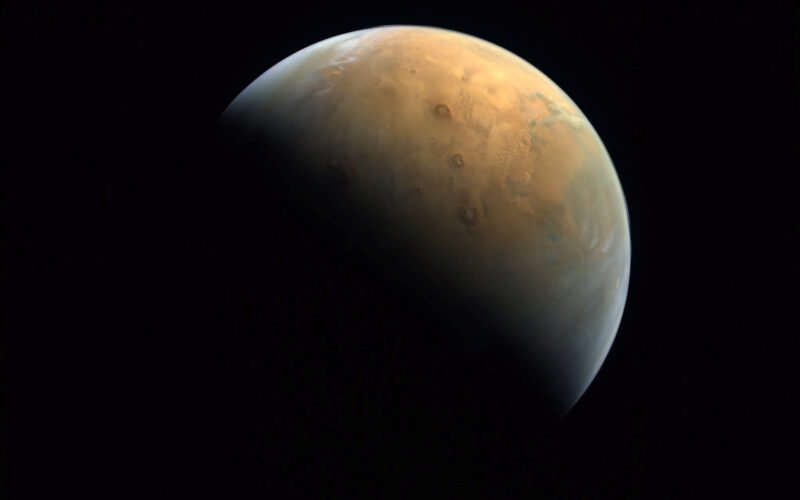While it may not have the experience of the United States, nor the means of China, the United Arab Emirates certainly has ambitious plans when it comes to space conquest.
Impressive beginnings
Since the establishment of the UAE Space Agency in 2014, the Gulf nation has reached several impressive milestones.
On October 30, 2018, the KhalifaSat was launched into orbit. While carried by the Japanese-made H-IIA rocket, it was the first spacecraft entirely designed and built in the Emirates. The main goal of this remote sensing Earth observation satellite was to provide high-resolution imagery of Earth.
A year later, in October 2019, a UAE Air Force fighter pilot, Hazzaa Al-Mansoori, spent a week on the International Space Station becoming the country’s first astronaut and the third Arab country after Saudi Arabia’s Sultan Salman bin Abdulaziz in 1985 and Syria’s Muhammed Faris in 1987.
On July 20, 2020, the ‘Al-Amal’ (Hope) probe was launched from the Japanese Space Center of Tanegashima with a far more ambitious objective: to study the variations of Mars’ climate over the seasons. To do so, it will mainly collect data on the oxygen and hydrogen content of the upper layers of the planet’s atmosphere. In total, the probe will spend a Martian year in orbit, or 687 Earth days.
On February 9, 2021, the probe reached Mars, a day before the 50th anniversary of the unification of the United Arab Emirates. On this highly symbolic date, the country also became the first Arab nation to reach the red planet.
We couldn’t have asked for a better day on Mars! Here it is, showing it’s weather system, from the dust and the ice clouds, can’t wait to see the science data come in so we can comprehensively characterize the lower atmosphere! pic.twitter.com/d3sv6vPuA9
— Sarah Al Amiri (@SarahAmiri1) February 14, 2021
As a result, Emirates joined an exclusive club of countries, which, at this time, only included the United States, Russia, India and the European Space Agency, to successfully send probes to Mars.
But the country is showing no signs of stopping here. The launch of the probe is part of the Emirates Mars Mission, a vast program focussed on building a colony on the red planet during the next 100 years.
While this project might sound like Science fiction, the UAE plans on creating a “scientific city” in the desert surrounding Dubai. There, the living conditions on Mars will be recreated as precisely as possible to develop the technologies necessary to colonize the planet.
Inspiring the next generation
The objective of this extravagant enterprise is to move away from an economy based largely on the export of oil and diversify industry. To do so, the UAE needs to inspire a new generation to enter the fields of science and technology. The message is already yielding results.
The UAE Space Agency already boasts more than 45% of women in its workforce, with many holding engineering positions.
“The project Hope is run by a team that is under 35, a team made up of 34% women,” said Sarah Al-Amiri, Minister of Advanced Sciences, who is also the chair of the UAE Space Agency and the Deputy Project Manager of the Emirates Mars Mission. “An entire nation is putting its hope in a team of youth and presenting a message to the region.”
Following the success of the Hope mission launch, a recruitment campaign for astronauts took place. Approximately 1,400 of 4,305 Emirati citizens that applied were women.
The Mohammed bin Rashid Space Center of Dubai, which oversees all manned space flights for the UAE, eventually announced that the next two astronauts would be Mohammed Al Mulla, a Dubai police pilot, and Noura Al Matrooshi, an engineer at the UAE’s National Petroleum Construction Company and the first Emirati female astronaut.
Like any spatial enterprise, the UAE space program also develops the country’s capacities in other fields, such as aeronautics, audio-visual broadcasting, and the surveillance of its territory.
After Mars? The Moon
The space agency’s next objective? To land a rover on the Moon by 2022. Named Rashid, the small rover will be transported onboard the Hakuto-R lander, developed by ispace, and launched into space from the Kennedy Space Centre in Florida by SpaceX’s Falcon 9 Block 5 rocket. The Emirates Lunar Mission will be the first journey for Hakuto-R.
The objective of the 10-kilogram Rashid rover will be to explore areas of the Moon which have not yet been reached during previous exploration missions. It will also carry out a series of experiments on lunar dust, and test technologies needed to survive in the extreme conditions of the Moon’s surface.
The first prototype of the lunar vehicle is already complete and should now undergo testing. The launch is expected to take place at the beginning of August 2022, and the rover should reach the Moon three months later, in November 2022.
As the first mission to the Moon conducted by an Arab country, this project will be yet another historical moment for the United Arab Emirates. The mission, if successful, would also make the UAE and Japan the fourth organization to reach the lunar surface after the United States, China and the late Soviet Union.

